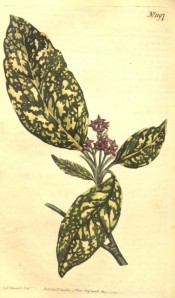Aucuba japonica Thunb. var. variegata
Fully hardy, rounded, evergreen shrub with elliptic to ovate glossy leaves, usually with a few marginal teeth, and small, red-purple flowers in spring. In female plants these are followed by bright red berries in autumn. Variegata is always female, and has yellow speckled leaves. [RHSE, Hortus, Hilliers’].
Horticultural & Botanical History
‘The Aucuba, of which one species only is known to us, grows into a large tree, and is very much cultivated in Japan for the beauty of its foliage; for we do not know that it is applied to any use. […] This shrub was for some years preserved in the stove, whence it was removed to the greenhouse or conservatory, and is now found to be as hardy as the Laurel or Lauristinus.’ [BM t.1197/1809]. ‘This plant was first introduced from Japan in 1783 by a Mr. John Graeffer, but only the female plant, and this under the well-known variegated form. From that one plant, the millions now scattered over Europe have been derived; but it is only in the last few years that, thanks to the indefatigable Mr. Fortune, the male plant, and in its native unvariegated form, has reached us.’ [BM t.5512/1865]. Poisonous when ingested.
History at Camden Park
Listed in the 1845, 1850 and 1857 catalogues [T.74/1845].
Notes
Published Feb 26, 2009 - 03:51 PM | Last updated Jul 14, 2010 - 04:47 PM
| Family | Aucubaceae |
|---|---|
| Category | |
| Region of origin | Japan |
| Synonyms | |
| Common Name | Spotted laurel, Variegated laurel |
| Name in the Camden Park Record | Aucuba Japonica |
| Confidence level | high |
